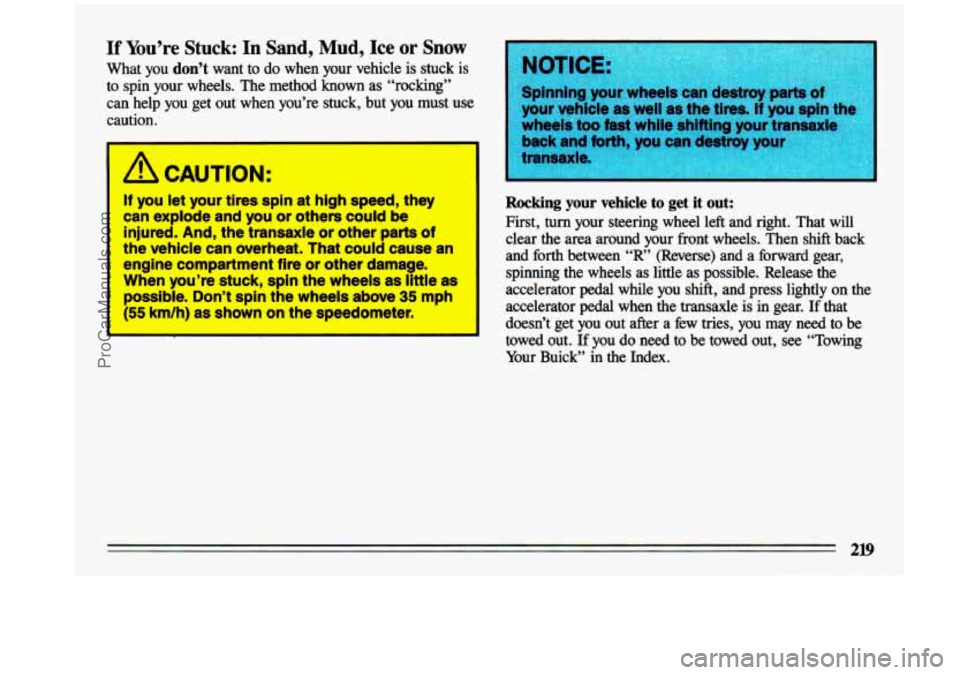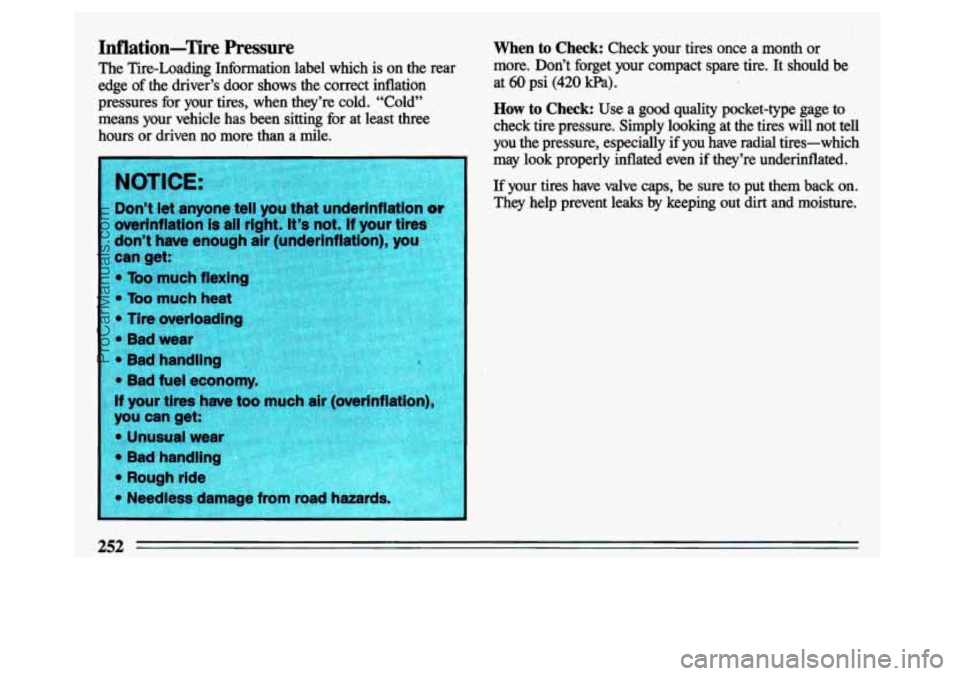1993 BUICK CENTURY tires
[x] Cancel search: tiresPage 207 of 324

8. Then replace the pressure cap. Be sure
the
arrows on the pressure
cap line up like this.
If a Tire Goes Flat
It’s unusual for a tire to “blow out” while you’re driving,
especially if you maintain your tires properly. If air
goes
out of a tire, it’s much more likely to leak out slowly. But
if you should ever have a “blowout:’ here are a few tips
about what to expect and what to do:
If a front tire fails, the flat tire will create a drag that
pulls
the vehicle toward that side. Take your foot off the
accelerator pedal and grip
the steering wheel firmly.
Steer to maintain lane position, then gently brake to a
stop well out of the traffic lane.
A rear blowout, particularly on a curve, acts much like a
skid and may require the same correction you’d use in a skid.
In any rear blowout, remove your foot from the
accelerator pedal. Get the vehicle under control by
steering the way you want the vehicle
to go. It may be
very bumpy and noisy, but you can still steer. Gently brake
to a stop, well off the road if possible.
If your tire goes flat; the next section shows how to use
your jacking equipment to change a flat tire safely.
Changing a Flat Tire
If a tire goes flat, avoid further tire and wheel damage ~y
driving slowly to a level place. Turn on your hazard
warning flashers.
A CAUTION:
Changing a tire can cause an injury. The vehicle can slip
off the jack and roll over you
or other people. You and they could be badly injured. Find a level place to change your tire.
To help prevent the vehicle from moving:
1. Set the parking brake firmly.
2. Put the shift lever in “P” (Park).
3. Turn off the engine.
CAUTION (Continued)
205
ProCarManuals.com
Page 220 of 324

Compact Spare Tire
Although the compact spare was fully inflated when your
vehicle was new, it can lose air after a time.
Check the
inflation pressure regularly. It should be
60 psi
(420 Wa). The compact spare is made to go up to 3,000
miles (5 0o0 km), so you can finish your trip and have
your full-size tire repaired or replaced where you want.
Of course, it’s best to replace your spare with a full-size
tire as soon as you can. Your spare will last longer and be
in good shape in case you need
it again.
on’t take your compact spare th
utomatic car wash with guide
ompact spare can get caught damage the tire and whe
her parts
of your vehicle.
Don’t use your compact spare on some other vehicle.
And don’t
mix your compact spare or wheel with other
wheels or tires. They won’t
fit. Keep your spare and its
wheel together.
s too. Don’t us
ProCarManuals.com
Page 221 of 324

If You’re Stuck: In Sand, Mud, Ice or Snow
What you don’t want to do when your vehicle is stuck is
to spin your wheels. The method known as “rocking”
can help you get out when you’re stuck, but
you must use
caution.
wneels can destr
If you let your tires spln at high spe& they
can aplode and you or others could be
Injured. And, the,transaxle or other parts of
the vehicle can &wheat. That could muse an
engine compartment fire or other damage.
When you’re stuck, spin the wheels 88 lltek adc
-pssSble. Don’t spln the whwls above 35 mph
(55 Wh) as shown on the speedometer.
Rocking your vehicle to get it out:
First, turn your steering wheel left and right. That will
clear the area around your fiont wheels. Then
shift back
and forth between
“R” (Reverse) and a forward gear,
spinning the wheels as little as possible. Release the
accelerator
pedal while you shift, and press lightly on the
accelerator
pedal when the transaxle is in gear. If that
doesn’t get you out after a few tries, you may need to be
towed out.
If you do need to be towed out, see “Towing
Your Buick”
in the Index.
ProCarManuals.com
Page 223 of 324

.
n
Part 6 Service and Appearance Care
. .
Here you will find information about the care of your Buick . This part begins with service and fuel information.
and then
it shows how to check important fluid and lubricant levels . There is also technical information about
your vehicle. and a section devoted to
its appearance care .
Part 6 includes:
Service ........................................................................\
..... 222
Fuel ........................................................................\
...... 223
HoodRelease ....................................................................... \
226
Engine Oil ........................................................................\
. 227
Aircleaner ........................................................................\
2.3
TransaxleFluid ..................................................................... 236
Enginecoolant ..................................................................... 239
Power Steering Fluid ................................................................. 241
Windshield Washer Fluid .............................................................. 242
Brakes ........................................................................\
.... 243
Battery ........................................................................\
.... 244
BulbReplacement ................................................................... 245
Tires ........................................................................\
...... 251
Loadingyourvehicle ................................................................. 249
Appearancecare .................................................................... 258
Vehicle Identification Number (VIN), Add-on Electrical Equipment ............................ 265
Capacities and Specifications .......................................................... -270
Fuses&CircuitBreakers .............................................................. 266
ReplacementBulbs .................................................................... 269
ProCarManuals.com
Page 251 of 324

Windshield Wiper Blade Replacement
-1
Replacement blades come in different types and are
removed in different ways. Here’s how to remove the type
with a spring release:
1. Pull the windshield wiper arm away from the
2. Press down on the spring with a screwdriver and pull
3. Push the new wiper blade securely onto tL wiper
windshield.
the blade assembly off the wiper
arm.
arm.
Loading Your Vehicle
G INFORMATION
VEHICLE CAP. WT.
FRT. CTR.
RR. TOTAL LBS. KG
MAX. LOADING
& GVWR SAME AS VEHICLE
1 CAPACITY WEIGHT XXX COLD TIRE
TIRE SIZE SPEED PRESSURE
RTG PSI/KPa
Two labels on your vehicle show how much weight it
may properly carry. The Tire-Loading Information label
found on the rear edge of the driver’s door tells you the
proper size, speed rating and recommended inflation
pressures for the tires on your vehicle. It also gives you
important information about the number of people that
,
can be in your vehicle and the total weight that you can
carry. This weight is called the Vehicle Capacity Weight
and includes the weight
of all occupants, cargo, and all
nonfactory-installed options.
249
ProCarManuals.com
Page 253 of 324

n
ACAUTION:
Things you put inside your vehicle can strike
and injure people
in a sudden stop or turn, or
In a crash.
* Put things In the trunk or rear area of your
vehicle. In
a trunk, put them as far forward
as you can. Try to spread the weight evenly.
* Never stack heavier things, IPke suitcases,
inside the vehicle
so that some of them are
above the tops
of the seats.
* When you carry something inside the
vehicle, secure
it whenever you can.
* Don’t leave a seat folded down unless you
need to.
Tires
We don’t make tires. Your new vehicle comes with high
quality tires made
by a leading tire manufacturer. These
tires are warranted by the tire manufacturers and their
warranties are delivered with every new Buick. If your spare tire is a different brand than your road tires, you
will have a tire warranty folder from each
of these
manufacturers.
A CAUTION:
Poorly maintained and improperly used tires
are dangerous.
0 Overloading your tires can cause
overheating as a ngsult
of too much friction.
Mu could
have an air-out and a serious
accident.
See “Loading bur Vehicle” in the
Index.
* Underlnflated tires pose the same danger as
overloaded tires. The resulting accident
could cause serious injury. Check
all tires
frequently to maintain the recornmended
pressure. Tire pressure should
be checked
when your tires are cold.
* Overinflated tires are more likely to be cut,
punctured, or broken
by a sudden Impact,
such as when you
hit a pothole. Keep tires at
the recommended pressure.
tread
Is badly worn, or If your tlps have
been damaged, replace them.
* Worn, old tires can cause accidents. If your
251
ProCarManuals.com
Page 254 of 324

Inflation-Tire Pressure When to Check: Check your tires once a month’or
The Tire-Loading Inforlnation label which is on the rear
’ more. Don’t forget your compact spare tire. It should be
edge of the driver’s door shows
the correct inflation at 60 psi (420 kPa).
pressures for your tires, when they’re cold. “Cold”
means your vehicle has been sitting for at least
three
hours or driven no more than a ‘mile.
How to Check: Use a good quality pocket-type gage to
check tire pressure. Simply looking at the tires will not tell
you the pressure, especially if you have radial tires-which
may look properly inflated even if they’re underinflated.
If your tires have valve caps, be sure to put them back on. \
They help prevent
leaks by keeping out dirt and moisture.
252
ProCarManuals.com
Page 255 of 324

Tire Inspection and Rotation
To make your tires last longer, have them inspected and
rotated at the mileages recommended
in the Maintenance
Schedule. See “Scheduled Maintenance Services”
in the
Index.
Use this rotation pattern.
After the tires have been rotated, adjust the front and rear
inflation pressure as shown on the Tire-Loading
Information label. Make certain that -all wheel
nuts are
properly tightend. See “Wheel
Nut Torque” in the
Index.
1
I A CAUTION:
Rust or dirt on a wheel, or on the parts to
which
It Is fastened, can make the’wheel nuts
become loose after a Qlme. The wheel could
come off and cause an accident. When you
change a wheel, remove any rust or dirt from
places where the wheel attaches to the
vehlcle.
In an emergency, you can use a cloth
or a paper towel to do this; but be sure to us8
a scraper or wire brush later, if you need to, to
get
all the rust or dirt off. (See “Changing a
Flat Tlre” in the Index.)
253
ProCarManuals.com